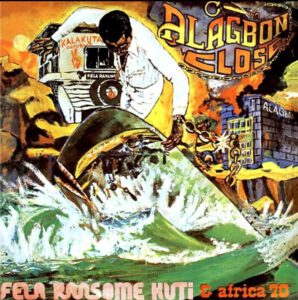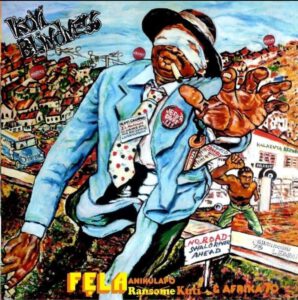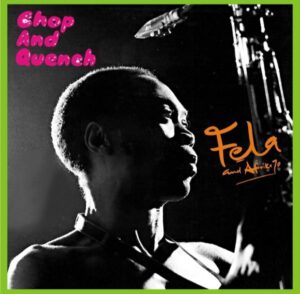By Sylvester Asoya
Lemi Ghariokwu, the well-known radical artist, still dominates the album sleeve art genre. After nearly fifty years of creating incredible designs for musicians across the world, this unusual designer remains an active voice in album cover and related creative activities in the music industry. And he is showing no signs of slowing down.
For many years, Ghariokwu worked mainly for only one client as an artist and graphic designer. That client, Fela Anikulapo-Kuti, the famous Afro-beat King who gave him his biggest creative platform yet, remains a major influence on his life. But he also added value to Fela’s band and brand with his creativity despite his relatively young age at the time. However, his most significant contribution is the fact that he designed the musician’s bizarre record sleeves and gave meaning to Fela’s vision as a revolutionary artiste with a mission. For this strange artist, meeting Fela was an outcome of an event already determined in advance by higher powers. “I was predestined to meet Fela”, he says. “I use the word predestination because I believe in destiny”.

Before he immersed himself in Fela’s album sleeves and other creative endeavours around Afrobeat and its creator, Ghariokwu had displayed a real creative spark with his talent and impressive design with the reproduction of Bruce Lee’s Enter the Dragon, the precursor to his inventive life and extraordinary work as an artist. This popular Chinese film of the 1970s/’80s changed the artist’s life and career forever. Apart from the phenomenal milage of Ghariokwu’s local representation of Enter the Dragon, the drawing also prepared him for his ultimate encounter with Fela and his rebel art. That eventful encounter, it must also be noted, gave him the opportunity to produce the album sleeves of Alagbon Close and Roforofo Fight, his two major outings after the Bruce Lee portrait feat.
But the artist’s view of his relationship with the Afrobeat maestro is telling and thought-provoking. “I did not work for Fela”, he insists. “I worked with him. We had divine collaboration for the purpose of mental liberation of Africa. Yes, our characters as individuals are different, but we share one hundred per cent, ideologically”.
Everyone who encountered the great musician, has a story. And like many of them, Ghariokwu enjoys reliving his experiences with Fela, the iconoclast and the unusual performer who claimed he had death in his pouch. “Life was interesting with Fela but at some point, I needed to go. I left him after four years but whenever they had any serious work, Dr. Beko Ransome-Kuti, his younger brother, would send for me. I walked away from the shrine but they used to invite me over for every important musical project”.

Surprisingly, this innovative artist is completely self-taught; he did not even study art or design in secondary school. His artistic journey actually began in earnest in 1974 when he started doing portraits in his neighbourhood. That year was indeed, the turning point for him because that was also the year he started receiving financial reward for his bourgeoning talent. He visited television studios regularly and did live drawings to the admiration of his play mates and friends at home who watched in admiration. He recalls how he drew the portraits of Mike Enahoro, the super journalist and Art Alade, the consummate entertainer who will always be remembered. In no time, recognition came knocking at the door. He also remembers how a communications company, Image Makers sent a letter through the Nigerian Television Authority, NTA inviting him for job interview.
But he also acknowledges the fact that there were influences along the way. They include the famous Yaba College of Technology Art School and their students. This is in addition to the artistic and stirring works of the institution’s art teachers and other young people like him who associated with the institution. He was also inspired by art icons like Ben Enwonwu, Yusuf Grillo and other renowned artists with their works and the exhibitions they organized. And for readers old enough to remember Osibisa, the group was similarly a factor in his life. This Afro Rock Band, well known for its excellent music, a fusion of highlife, rock, jazz, Caribbean, funk and Latin streaks, also played a major role in Ghariokwu’s life and creativity as an impressionable young person conscious of the future.

Art has also taken Ghariokwu to important people and places in the world. Apart from producing over 2000 covers in the last forty-five years, and 29 album sleeves for Fela, he equally designed over 200 covers for Polygram Records where he worked for 11 years. And at different times, he worked for Premier Music and other recording companies like EMI and Sony. In addition, he also designed for great artistes like Evi-Edna Ogholi, The Mandators, Ras Kimono, Orits Wiliki, Onyeka Onwenu, Osita Osadebe, Ebenezer Obey and Oliver De Coque. He did covers too for other well-known musicians like 2Baba, Daniel Wilson, Tony Tetuila, Mike Aremu, Sound Sultan, Bob Marley, Lucky Dube and Mariam Makeba.
Today, Ghariokwu still stands out in the creative world because as a teenager, he chose the right path early. He also followed his passion instead of studying engineering which, like most fathers back in the day, was his parents wish for their young son with inclination to sciences. So, what began like a pastime and creative hobby, is now a big career, bringing fame and fortune to this introvert artist who is never afraid to dare.
It is interesting to state however, that this Nigerian artist is already receiving attention in many quarters. He is now a subject of interest for authors in Nigeria and outside who are documenting his productive life as an artist globally known at the moment as ‘King of Covers’.
“I am an evolutionary, not a revolutionary. But I love the energy revolutionaries bring to society”, he says.
This designer who claims that he is not in competition with anyone, says that he loves his own company. According to him, he usually competes with himself and his past. For him, that is the only way to get better and get the most out of life. But Ghariokwu is also a poet and lover of music. “I love music, that is why lyrics are very important to me”. For him, lyrics are vital because they help society in different ways. And like some people of his generation, he is very uncomfortable with the lyrical content of today’s music because of the damaging effects that come with some of them. No doubt, he loves Burna Boy and other talented artistes who have the ability to produce great songs around love, identity, nationalism, culture and ideology without losing focus.
Ghariokwu is a great artist, no doubt. His strength is in his body of work and the fact that he continues to produce and adapt. At 65, he still holds promise even as the art terrain continues to change.
(This article was first published in alice, the in-flight magazine of Air Peace.)
• Asoya is a senior journalist and prolific art writer.